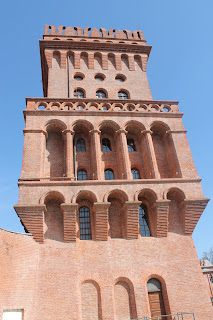Pollenzo, ancient Castrum and Insula of Roman times, Medieval Church and Castle, well preserved for posterity, secret laboratory of Gastronomical inventions and vault with the richest wines of the valleys of the Langhe, the Roero and the Monferrato.
The Church of San Vito, built in 1842 in
Neo-Piedmont Gothic style
Sometimes understanding geography is difficult, more so in a foreign country. Even with a GPS. If you look at a map, you see the streets, the neighborhoods, the zip or postal codes, the town or city or city you are in, the county, the country and the continents.
However, when you are in a wine region, some locations are more difficult to find, more evasive. In the case of hand, some of the DOCG (Determinazione di Origine Controlata e Garantita) are easy to find, such as Asti, Barolo and Barbaresco, because each one of them is a town, while others are more vague, such as in the case of Langhe-Roero and Monferrato. This is not because people in the wine business are in hiding, but because what determines a DOCG isn't an address, but where one type of grapes grow, or where a field or vineyard ends, because a creek passes by.
On the left flank of San Vito Church is the
Cookery School and the Corte Albertina Hotel.
The last day we were at Alba, while we were having a delicious "colazione" or breakfast, with fruit, juices, ham, cheeses and bread, I was looking at the back wall of the dining room, decorated with a beautiful wall-to-wall poster of vineyards, with the title: "Langhe-Roero e Monferrato, UNESCO World Heritage Site." So I asked the waitress, "Where's Langhe? Roero?"
The statues of Saints Victor,
Charles Borromeo, Ferdinand
and Theresa flank the upper levels
of the façade.
She answered me with one of those nonchalant gestures so typical of Italian women, and that we foreigners cherish so dearly, which Estela and interpreted as meaning "everywhere" or "everywhere around here". However, when we pressed her for more specific directions, she said: "Go to Pollenzo!" So off we went, off to look for another town we had never heard of before, a "Castrum" (camp or settlement) in times of the ancient Rome, then called: Pollentia.
The elevated passageway
between San Vito Church and
the parish hall is neo-Gothic
Italy is the place of reengineered buildings and historically multilayered sites. This descriptions is true of Pollenzo. After its days as a Roman settlement, it was "rediscovered" during the middle ages, to be forgotten again, until the mid-19th Century, when the Savoy Dynasty of the Kingdom of Italy made Pollenzo their royal residence. After World War II, Pollenzo was the site where the King of Italy rescinded from the Monarchy. In the last 20 years it was re-discovered again, this time as the center of the University of Gastronomical Sciences,, the Slow Food Institute, and la Banca del Vino.
Behind Estela, the Forum, the Tower
and l'Agenzia.
This quadrilateral complex was a 19th Century
Gothic revival project of King Carlo Alberto,
and executed by architect Melano.
The arcades of the Forum are
Gothic, while the design of the
tower is completely fanciful
This tower's battlements are
inspired in medieval ideals,
while the style is merely
trabadour
Behind the parked cars is the private residence of
the decedents of the Savoy Royal Family.
Roman castrum is revealed by
archeological dig behind Estela
This plaque declares Pollenzo
as a UNESCO World Heritage
Site.
One of several boutique hotels
in Pollenzo
A peep inside a small boutique hotel.

















No comments:
Post a Comment